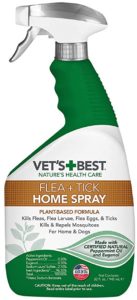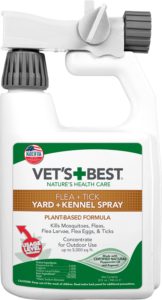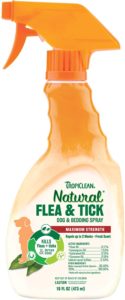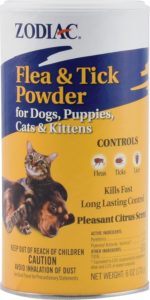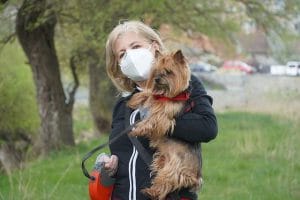My dog is my four-legged companion, my early warning system, my fur baby, and my friend. She shares almost as much with me as my human kids do, often sleeping in my bed, eating parts of my meals with me, and spending time outdoors with the kids and I. That means that she gets into every room and every corner we do, including our bedding and our carpets. So, when my dog has fleas, we all do.
Having fur and being so close to the ground all the time has its cons. Most notable of those are the pests that irritate and infest our fur kids. Depending on where you stay and what your outdoor activities are, those pests probably include ticks, worms, mites, and fleas. Worst still, a lot of these pests bother your dog because she has a flea infestation.

What are fleas?
A parasite that feeds on blood from the animals it latches on to, fleas can infect dogs, cats, bird, rodents (like mice, hamsters, and rats), and small wildlife in wooded areas, such as rabbits, hedgehogs, and even foxes! It is estimated that there are 325 identified species of fleas in the United States and Canada alone, and more than 2,000 species worldwide. Interestingly, only 22 of those species bite dogs, cats, and humans.
Most flea species prefer hot, humid, and moist areas to breed in, disliking cold climates. Fleas prefer a temperature range of about 75-85 degrees Fahrenheit but have however adapted to both colder and warmer climates.
Although each animal species has a flea that commonly causes irritation when bitten, in domestic house pets like dogs and cats, it is ironically mostly the cat flea that bites both pets and humans in the United States. And unlike most other flea species, the cat flea does not leave its host.
What causes fleas?
The environment plays a huge role in where pests live. Fleas and ticks notoriously hang out in your garden, and in the parks you take your fur babies for walks in. Cats are roamers by nature, and seldom stay home for long, preferring the warmth of tall trees or house roofs in the garden. Cats also tend to wander off and visit other houses and cats in their immediate vicinity, often staying out until all hours of the night. The result? Cats can sometimes carry home more than just a dead mouse!
Fleas (of the order Siphonaptera, class Insecta) pass through four stages in their lifecycle, illustrated below.
Figure 1: Life stages of the common household flea
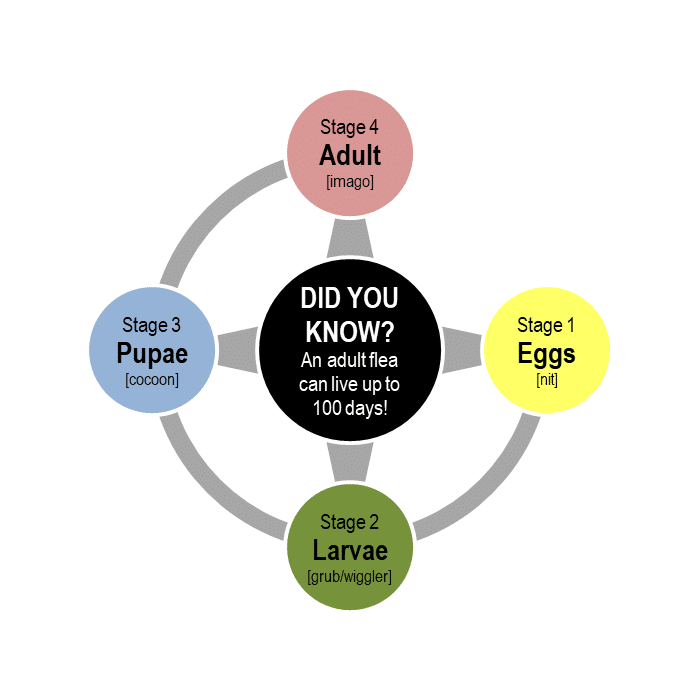
© ourpetsite.com, 2020 Adapted from https://www.onlynaturalpet.com/blogs/holistic-healthcare-library/lifecycle-of-a-flea-diagram
An adult flea can live for up to 100 days, and lay at least 2,000 eggs in her lifetime. This rapid reproduction rate means that – on any given day – you could be dealing with a nest full of fleas at varying stages of development and egg-laying activity. Adult fleas must first feed on blood before they are able to reproduce.
Fleas will avoid light, and make their nests in the host’s (you or your pet) most-occupied spaces. This includes the spaces around your dog’s bed, the human beds, feeding bowls, and favorite spots in the garden. Fleas are never far from their food source, and in the case of cat fleas, they never leave their host.
Fleas travel to new hosts and environments mostly in their early stages (before adulthood) and nests are established quickly. Fleas can travel on animal fur, human clothing, bags, blankets, and even car seats. Nits, larvae, and emerging pupae are easily picked up due to their tacky, sticky outer layers, and drop off objects just as easily.
Eggs are laid roughly 2 days after an initial blood meal, and then the developing eggs feed on leftover droppings, dirt, dried blood, and other host DNA material, left behind by the adult flea to feed her litter. Once the eggs have fully matured and reach adulthood, they will feed on real blood and then begin the process of laying more eggs.
Stay informed. Check your state’s flea and tick alert levels here.
Top 10 ways to tell if my dog has fleas
While fleas do prefer their own host, it’s not uncommon for humans in the same household to be bitten by the fleas from their dogs and cats. One of the telltale signs that fleas have started munching on the human population are small, itchy, red bumps on ankles and feet. Irritating and ongoing, the only way to get rid of the flea bite problem is to treat the flea infestation holistically.
Easier said than done, right?
Top 10 signs that your dog may have fleas
1. Itchy, red skin
More noticeable in cats than dogs, stroking the places your pet has been scratching will tell you the extent of the irritation, and skin lesions (cuts and scrapes) should be evident from the scratching.
2. Scratching
Your pet will have been trying her best to get rid of the thing that continues to bite her in that specific warm, furry place. Continuous scratching will damage your pet’s skin, and leave scars and bald patches of fur.
3. Bleeding
An inevitable result of ongoing irritation, it won’t be long before you notice bald, weeping, or bleeding patches on your pet.
4. Licking
In an attempt to soothe the damage already done to her soft skin, your pet may take to licking the affected area instead, or perhaps because it brings her temporary relief from the pain and discomfort she caused.
5. Hair loss
Buy natural, eco-friendly flea treatments today!
Wondercide Natural Products - Flea, Tick and Mosquito Control for Dogs, Cats, and Home
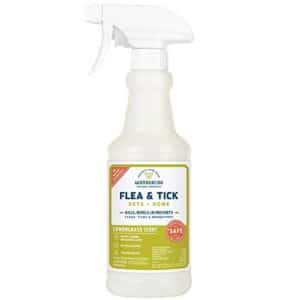
6. Human bites
When flea nests are created inside of a human home (such as by the dog’s bed in the kid’s room), human movement disturbs the nest and gives eggs, larvae, and pupae the chance to travel between rooms and create additional nests. Each flea colony is capable of laying thousands and thousands of eggs every quarter, and deep cleaning means every room in the house has to be treated.
DID YOU KNOW?
Fleas “poop” as they bite, resulting in infections at the site of the wound.
To treat insect bites, wash gently with warm water and soap to minimize your risk of infecting the site with additional dirt. Apply a topical anti-itch cream to the affected area, and remember to take an anti-histamine if you expect an allergic reaction (such as seen in diabetics who are bitten by insects).
7. Bedding and carpets
Fleas are so small and it’s not always easy to see if there are any on your bedding or your dog’s beds. Treating flea infestations like lice infestations is the natural way of managing flea infestations. While this may seem like odd advice, washing your linen in boiling hot water also rids it of any other pests (such as lice, dust mites, and bedbugs) that may be lurking there. Carpets are – in our opinion – one of the biggest culprits in pest infestations, collecting dirt, food, dead skin cells, shed fur, and other organic material. This organic material is a feast for a colony of pests.
8. Cleanliness
Using a broom and pan to clear out dusty corners is a good start. If a Hoover is not an option available to you, you may need to call in a pest control expert (depending on your level of infestation). Wooden floors are a favorite for flea infestations, and are actually easier (and cheaper) to clean than rugs, mats, or carpets. Remember to disinfect and wash your brooms, mops, and Hoover dust bag in boiling hot water to kill any fleas or developing flea eggs your cleanup collected along the way.
9. Worms
Whilst it is not really common for humans to get cross-infected by tapeworms from their fur babies, it is possible to ingest an infected flea, and develop human tapeworms, a parasite that lives in your intestines. Keeping your food preparation areas clean is key to managing your health and well-being, especially when everyone is already irritated by cleanup, disruption, and possible flea bites.
10. Disease
Apart from tapeworms, anemia is a serious condition that results in a low blood count in puppies, kittens, and smaller breeds of dogs and cats. Anemia causes jaundice, loss of appetite, and lethargy (lack of energy). Murine Typhus is rarely found in the United States, and mostly in Texas and Southern California. Fleas are carried by infected cats. Those fleas then bite and infect human hosts, causing fever, nausea, aches and pains, and more.
DID YOU KNOW?
The Bubonic plague is spread by small animals and rodents, but is actually caused by transmission of the disease from infected fleas that carry the bacteria Yersinia pestis (formerly Pasteurella pestis).
How can I prevent flea infestations in my dog?
Considering that only a small percentage of your average flea infestation population is of adult size, treating your home will require a holistic approach that treats fleas at all stages of development. We recommend eco-friendly dog flea and tick control, not just to protect the environment overall, but also to keep your home free of harmful chemicals and pesticides.
Using sustainable pet products will not only ensure that you give back to the environment, but that you give your fur babies the best possible chance at a healthy life. Remember to use pet-friendly and child-friendly disinfectants when you clean and disinfect the rooms in your home.
Regular grooming removes dead skin cells, loose fur, and quite a bit of any leftover debris, dirt, pest eggs, and the like that your pet can collect along the way. It’s also a great way to keep your dog’s coat shiny, healthy, and looking good.
Buy eco-friendly products here.
Watch: How to get rid of ticks and fleas on dogs and cats
Fleas and ticks are an everyday problem. Affordable, effective measures in treating flea infestations are possible, and with a little added effort, keeping your home free of pests is doable. That doesn’t mean that the pests will stay away forever, just that you managed to take back control of your home – for now.
It’s always best to consult with your preferred veterinarian or nearest animal clinic if you notice any change in behavior that could indicate your dog has fleas.
You may also like
My pet and COVID-19
The Coronavirus (COVID-19) pandemic has caused world-widehavoc in all the countries where it is now...
Read MorePuppy Food – Feeding Guidelines
For the first 6 weeks of your new puppy’s life, her mother sustained her with...
Read MoreWhаt Dоg Fіtѕ Mе Bеѕt?
Onе оf thе tоughеѕt questions to аnѕwеr for a рrоѕресtіvе dog owner is, “Whаt dоg...
Read MoreSenior Dog Feeding Guidelines
A ‘senior dog’ refers to the age at which any particular breed-size of dog will...
Read MoreTraining my new puppy
Basic training for your puppy It is important to train your puppy from the beginning...
Read MoreCommon nutritional disorders in dogs
You know you’re doing the best for your pooch and feeding her the way you’ve...
Read More

